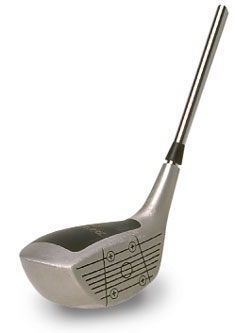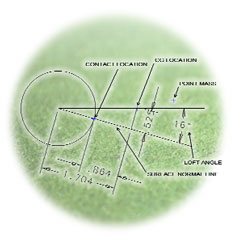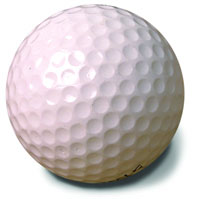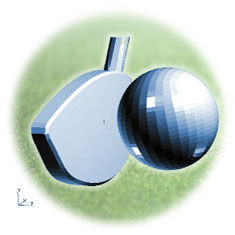January 1, 2005
By Carl J. Poplawsky
Sports equipment equipment manufacturers put a lot of engineeringeffort into improving the performance of their products, yet they stilldepend on physical prototypes and subjective user evaluations tooptimize both the performance and durability of their designs. Thistraditional product development cycle—design, build and test—is notonly open to subjective vagaries, but is cost and time prohibitive. Tosolve these three issues,

Engineering Science Analysis Corp. (ESA)recently developed a finite element (FE) parametric model for a golfclub for a client. The models used MSC’s virtual product development(VPD) tools, including MSC.Patran for FE model pre-processing,MSC.Nastran for linear stress analysis, and MSC.Dytran for nonlineardynamic impact analysis. MSC.Dytran is a 3D-explicit solver forsimulating high-impact, short-duration nonlinear events, such as ballimpact performance of sports equipment.
The result of the project is a generic golf club model that accuratelypredicts performance and durability as a function of key designparameters before investing in physical prototypes for the test range.Geometric and engineering parameters for any manufacturer’s club design(driver or iron) can be quickly and easily entered into a simulationthat produces objective and repeatable data about numerous physicalrelationships. Design parameters include swing speed, head loft angle,head mass and center of gravity (CG), head face material and thickness,hitting location, and shaft stiffness. Hitting performance factors likefinal ball speeds, departure angles, spin rates, ball contact force,impact coefficient of restitution (COR), and head face stress can beevaluated as a function of these parameters, allowing a designer toidentify optimum parameter combinations for a particular set of designobjectives.
Generic Golf Ball FE Model
Before driver performance could be evaluated, the ball had to becharacterized within the context of engineering parameters. The dynamicstiffness of the ball determines how it interacts with the club head,and is heavily controlled by golf’s regulating authorities. The balldynamic stiffness depends on its material modulus of elasticity (forstatic compression effects) and dynamic viscosity (for high-speedimpact effects).

Side view of club head showing face center normal line , loft (face)angle and point mass. The actual head CG is not at the same location asthe point mass, because the point mass represents only the sides andback of the club head. The point mass was positioned so that theresulting head CG location matched the CG location calculated by thesolid model of the head.
To determine ball modulus of elasticity, a linear elastic FE model ofthe ball with geometric contact to a rigid surface, was created usingMSC.Patran and solved in MSC.Nastran for static force-deflection.Results were compared to test data, and the elastic modulus was “tuned"until the analytical results matched the physical test data. Duringdriver high-speed impact, a golf ball exhibits viscoelastic effects(consisting of very large deflection deformation over a very shortperiod of time), leading it to behave differently than it does whenunder a static load. The material dynamic viscosity is used inMSC.Dytran to describe these viscoelastic effects, and was determinedusing ball-wall impact test data collected with high-speed photography.Using MSC.Dytran, high-speed ball impact with the rigid wall wassimulated, and the COR for multiple speeds was predicted and comparedto experimental data. COR is a measure of the remaining ball energyafter impact and, for ball-wall impact, it is the final speed dividedby the initial speed. The ball’s dynamic viscosity was tuned until anx,y plot of COR as a function of impact speed matched the experimentaldata plot.
The analysis of the ball-wall impact event using MSC.Dytran indicatedthat ball-wall peak contact force is a strong function of initial ballspeed. Additionally, ball-wall contact duration and resulting COR areboth a weak function of initial ball speed. The results closelycorrelated with available empirical data, allowing us to move forwardwith confidence in evaluating driver performance and durability inhigh-speed impact.

Ball direction vectors where Z is down the fairway, Y is elevation orheight and X is the direction the ball goes during a hook or slice. Ashead speed increases, launch angle (and hence ball elevation) caneither increase or decrease depending on head CG location (offset).
Generic Golf Club FE Model
The FE model of the generic club driver was developed using the I-deassolid modeller (now a part of UGS Corp.) and MSC.Patran. ESA’s goal wasto develop a model that could be easily configured with varying facegeometries. We modelled these parametrically to include thickness,bulge, roll, and head angle. The rest of the head geometry was notmodelled, since the remaining head surfaces (which contribute to headmass and CG/inertial characteristics but not to stiffness) could berepresented concisely with a simple point mass. Use of the point masslimits geometric changes to only head parameters, keeping the modelsimple, easy to modify, and quick to run in MSC.Dytran. Thecontribution of the remaining head surfaces can be easily simulated bychanging mass and inertial values of the point mass, and moving thepoint mass geometrically.
Using MSC.Patran, the face was meshed with shell elements to make iteasy to change the thickness distribution, using only a simple FEparameter. The point mass was connected to the face using masslessbars, and point mass and inertia values along with geometric locationwere defined to produce the desired overall head mass, CG location, andhead inertial properties.The golf shaft was simulated with FE beam elements, using a stiffnessconsistent with a popular graphite composite shaft. Rotational velocitywas defined in a way that provided good simulation of the golf swing.The resulting model solves for a swing-impact event, using a typicalPentium 4-equipped Windows machine, in under two hours. The model isgeneric enough to address any desired design parameter for both driversand irons.

Generic Golf Club Driver Analysis
The analysis of the ball-club impact event for various initial swingspeeds using MSC.Dytran indicated that ball spin rate, club head facedynamic stress, and ball-club peak contact force are strong linearfunctions of initial swing speed. In other words, as swing speedincreases, ball spin rate, dynamic stress on the club face, and peakcontact force all increase. Additionally, the ball launch angle andball-club impact COR (consequently final ball speed) are very weakfunctions of initial swing speed. The analysis of initial swing speedresulted in a close correlation with empirical data for the ball-clubimpact COR.
The analysis of the effect of the ball impact event for various faceloft angles indicated that ball launch angle, the ball spin rate, andball-club impact COR (consequently final ball speed) are strong linearfunctions of head loft angle. In other words, a greater loft angleresults in more ball elevation, more ball spin, and a slower ballspeed. Additionally, the club head face dynamic stress is a weakfunction of loft angle.
The analysis of the ball impact event for various head CG offsets(defined as the distance of the CG from the face center normal line)indicated that ball launch angle is affected by head CG offset. Aneffective loft angle can be identified when given the head CG offset,and can vary from the geometric loft angle by as much as two degrees.This tends to indicate it’s important to consider both CG and itsrelationship to the loft angle for determining the ball launch angle.The ball-club impact COR (consequently final ball speed) is a moderatefunction of head CG offset while the ball spin rate is a weak function.The COR is optimized by aligning the CG with the face center normalline, effectively establishing a zero offset.

MSC. Dytran allowed us to actually see what the ball is doing. Areference was added to the ball representation so that ball spin speedcould be determined.
Our analysis showed that drivers will deliver maximum payback when youput the CG right at the head face center normal line. Assuming the ballis hit perfectly, when the CG is low, the club face lifts the ball;when the CG is high, the effective loft angle is reduced. Shifting headCG location (to provide offset) using the model as a guide, can be usedto compensate for an individual’s tendency to hit the ball at the edgesof or outside the ball hitting zone on the face, compensating forhooking, slicing, topping, or undercutting tendencies.
Versatile Methodology
MSC.Dytran can be used effectively for impact sports equipment design.It is essential to tune ball material properties with data from staticforce deflection and ball-wall impact at multiple speeds beforeequipment impact analysis is performed. ESA has successfully correlatedgolf ball impact COR data for both wall and golf driver impact. The ESAgeneric driver model is an effective tool, able to provide designguidance quickly and efficiently to determine the effects of any andall design parameters on ball launch speed, impact efficiency (COR),launch angles, ball spins, and face dynamic stress levels. In fact, wehave applied this same methodology to other sports equipment includingsoftball and baseball bats, with excellent results.
Carl J. Poplawsky is vice president of engineering for EngineeringScience Analysis (ESA) Corp. To contact him about this article, send ane-mail to [email protected].
Company Information
MSC.Software Corp.
Santa Ana, CA
mscsoftware.com
Subscribe to our FREE magazine, FREE email newsletters or both!
About the Author
DE’s editors contribute news and new product announcements to Digital Engineering.
Press releases may be sent to them via [email protected].






